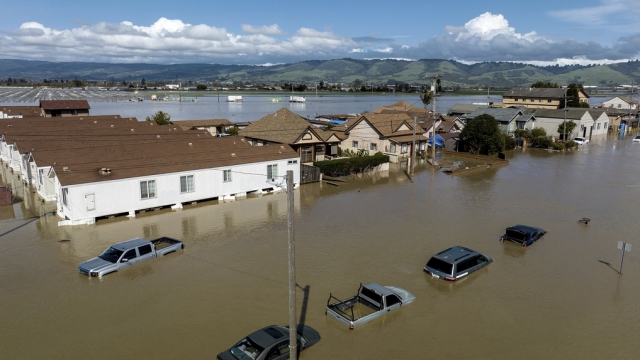In California's mountains, the great melt is underway — a runoff of dozens of inches of water packed inside feet of snow from the state's mammoth winter storms.
The water is creating a torrential threat for low-lying communities susceptible to flooding and to the state's infrastructure, already failing under the weight of spring.
"From Mammoth down to Yosemite and all the way down to Tulare County, that's probably the worst area because that's the wettest area; they still have between 90 and 100 inches of water," said Alex Tardy, National Weather Service meteorologist. "Even in the Lake Tahoe area, it's anywhere from 60 to 80 inches of water. That's almost two seasons of water stored in that snowpack that still has to come down."
California's Los Angeles Aqueduct — which, as the name suggests, is a critical waterline serving the state's largest city — failed in March. Crews have worked to reinforce the pipeline, but they worry it may not be enough with so much water expected to flow this spring.
In Crestline, a community in the San Bernardino Mountains near Los Angeles, residents are still picking up from a season that put them in the crosshairs of a first-ever blizzard warning for the area. The roof of a local grocery store pancaked, and many residents are staring down tens of thousands of dollars in damage to their homes.
"2023 was unlike anything we've seen in at least 40 years," Agina Sedler said, standing outside the fenced-off grounds of the now-closed Goodwin & Sons Market, now just a shell of the former grocery store that collapsed in March.
Sedler watched her home security camera from a distance as snow piled high on her own roof.
"My chimney was sheared off at the base of the roof and all that snow, including the chimney itself, fell onto my deck and completely demolished my entire deck," she said.
SEE MORE: Severe weather threatening 59 million people in end of April
Sedler is far from alone. That's why FEMA established a disaster recovery center between Crestline and neighboring Lake Arrowhead. State and federal agencies there provide residents with financial resources to rebuild after the storms.
Kevin Martinez saved for months to afford a move to Crestline last May. His son, he said, thrived in a better school district. But in February, as storm after storm piled up the snow, a building under construction across the lot from him collapsed, opening "like a flower," he said.
"They showed up and turned off the gas right after, and that's when it really started to get bad," Martinez said.
Martinez said his landlord, who owns both properties, cut off shared water and gas supplies after the collapse. That left him, his wife and two young children without water or gas services, which he says have yet to be restored.
"I've been having to get water from my neighbors and put it in a trash can, force flushing everything," he said.
Now he plans to move back down the mountain, to the city of San Bernardino, where he left last year.
"I'm grabbing whatever money I can so I can get something cheap for my family. Just — I can't live like this," he said.
It's stories like his challenging the mountain communities to band together, coalescing to survive a brutal year and perhaps even use the devastation as a reason to revitalize a tourism-reliant region.
SEE MORE: As a California drought improved, flooding brought problems
Mike Lardi works with the chamber of commerce in Lake Arrowhead. He's convinced the storms will serve as a "catalyst" to enliven residents to the area's potential.
"You've never seen a group of fired-up seniors in your life 'til you see these people ... The energy is just undeniable," he said, recounting the days after the worst of the storms when community members met to discuss best routes forward.
Tourism is essential to the area's success, but some residents worry the headlines from the last several months will keep people away this year.
"Our funds are all going to go to fixing our homes," Sedler said. "I'm sure we're really going to be relying on those tourist dollars to help us get by this year."
While Sedler insists the community wasn't caught unprepared for the snow, the severity of the season was perhaps a prelude to climate change-induced severe winters to come. Lessons learned this year will help California prepare for more seasons like this one.
"We're going to have to improve either transport or storage [of water]," Tardy said. "In a really wet year like 2016-17, just a few years ago, [we] released millions of acre feet of water back into the ocean because it was just coming down too hard, too much. That's what happened this year too in January and March. That's a lot of water lost."
Trending stories at Scrippsnews.com



